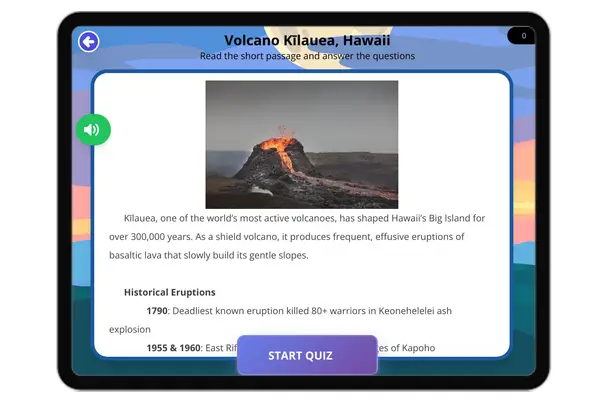Obsidian: The Natural Glass Rock — Reading Comprehension
Grades
- 5
- 6
- 7
- 8
Standards
- MS-ESS2-3
- MS-ESS3-2
- RST.6-8.4
PRINT+DIGITAL RESOURCE
This learning resource is available in interactive and printable formats. The interactive worksheet can be played online and assigned to students. The Printable PDF version can be downloaded and printed for completion by hand.
About This Reader
This science reading passage explores obsidian, a volcanic glass that forms when lava cools so rapidly that crystals cannot develop. Written for middle school students, the content clearly explains that obsidian is an igneous rock, specifically a volcanic rock, answering the key question 'What type of rock is obsidian?' The passage aligns with NGSS standard MS-ESS2-3 (Earth's Systems) by examining how Earth materials form through specific geological processes. The text covers obsidian's formation process, unique glassy appearance, physical properties including conchoidal fracture and extremely sharp edges, geographic distribution near silica-rich volcanoes, and historical human uses from ancient tools to modern applications. The accompanying 8 multiple-choice questions assess students' comprehension of main ideas, key details, and vocabulary in alignment with Common Core Reading Informational Text standards. This resource helps students understand volcanic processes, rock classification, and the relationship between cooling rate and rock texture within Earth's systems.
Perfect For:
👩🏫 Teachers
- • Reading comprehension practice
- • Auto-graded assessments
- • Literacy skill development
👨👩👧👦 Parents
- • Reading practice at home
- • Comprehension improvement
- • Educational reading time
🏠 Homeschoolers
- • Reading curriculum support
- • Independent reading practice
- • Progress monitoring
Reading Features:
📖
Reading Passage
Engaging fiction or nonfiction text
❓
Comprehension Quiz
Auto-graded questions
📊
Instant Feedback
Immediate results and scoring
📄
Printable Version
Download for offline reading




















